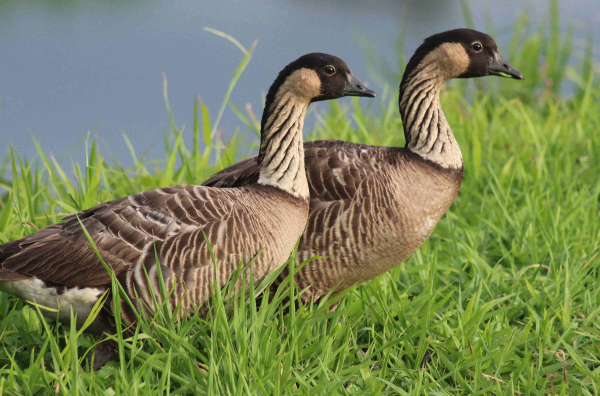
Vibrant green color surrounds a NeNe pair after a late rainshower; the low evening light required the rare use of a 1600 ISO rather than the usual 400 (photo info: 350mm zoom lens, f-8 aperture, 1/800 shutter speed, ISO 1600).
At this point in the northern winter, day-dreaming can be useful, even therapeutic; after all, isn’t it something of a creative process. On cold, windy, dreary days with everything covered in white and not a green leaf to be seen, my thoughts sometimes turn toward the Sunbelt and all the kool birds I would search for with photos in mind and my camera in hand. But why stop there, keep thinking south – the coasts of Mexico, the rainforests of Central and South America, the wildlife of East Africa, India, Malaysia, Australia, and points in between. It brings back exciting memories of photographing green zone birds after hiking a rocky trail beyond the end of a remote road, or searching for photo ops after leaving a boat and hiking inland from the shore of a jungle river. Ahhh, beam me there Scotty!

The details and lighting of this NeNe’s neck, face, eye, and bill are impressive in this close NeNe portrait. What a thrill it was to spend time among these impressive native geese (350mm zoom lens, f-10 aperture, 1/800 shutter speed, ISO 1600).
|
While living beachside in San Diego, which is not a bad March destination in itself, I had a free week between 2 work contracts a few March’s ago, and before I started the next project I felt the need for a little change of venue before diving deep into a desert-based ornithology project. So what’s the opposite of a desert? A tropical island! Ya, that’s it! And flights from San Diego to the tropical isles of Hawaii were exceptionally reasonable at that time – but which island? I have enjoyed birding on the big island of Hawaii, and touched base on Oahu, but have always been interested in Kauai, the northern-most and western-most of the principal islands in the Hawaiian archipelago.
In addition to the variety of native and introduced birds found on Kauai, which included a nice population of the Hawaiian state bird – the NeNe, or Hawaiian Goose, I knew from talking with my friend Ned Harris that Kauai had a great seabird photography site on its northern-most tip – Kiluaea. Plus I was very aware of one of the most remote hiking destinations in America, located on the west side of Kauai, the Alakai Swamp, which is really more of a steep green mountainous destination. The slopes are green from the lush vegetation that grows there as a result of more than 400 inches of rainfall each year – it’s the wettest place in the United States. This remote location is also a prime destination to find many of Hawaii’s native birds, ranging from super-rare to relatively common – I’iwis, Apapanes, other Hawaiian honeycreepers, and more. So I was primed for Hawaiian bird photography, and after a “quick” flight across half of the Pacific Ocean, I hit the red earth running.
I spent most of my time on the north shore, from the hamlet of Hanalei to the village of Kilauea, an area that holds a sweet place in my birding heart. In that area, 2 national wildlife refuges provided excellent bird photography opportunities – also named Hanalei and Kilauea refuges. Hanalei is so laid back and relaxed with NeNes, gallinules, ducks, and other waterbirds feeding, swimming, and resting in lush surroundings; but Kilauea is very different.
Kilauea Seabirds
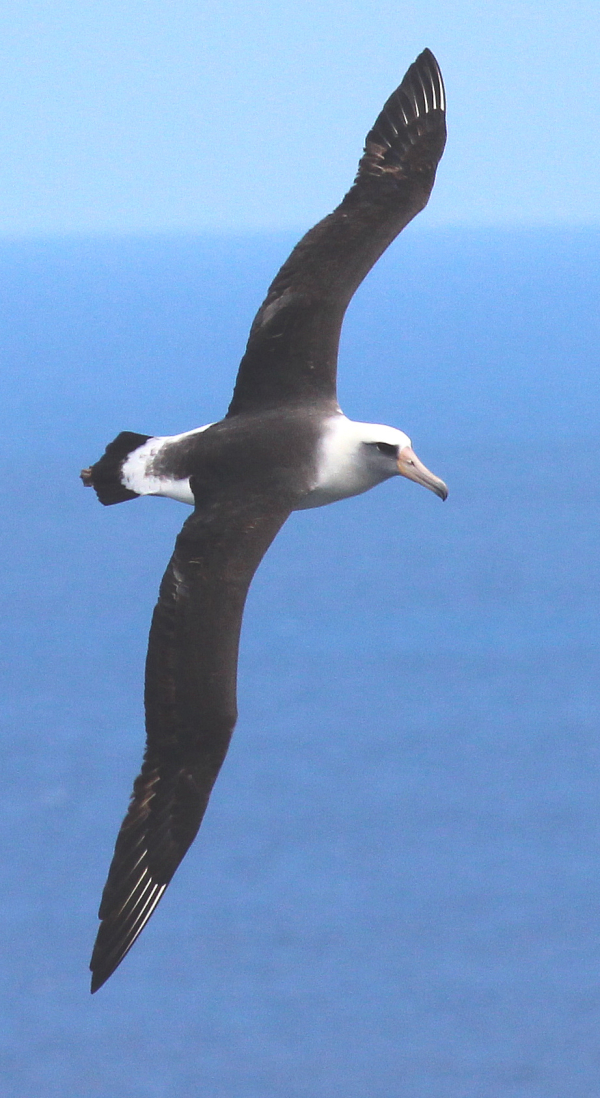
The extra-long wingspan of a Laysan Albatross banking on a stout wind and positioned against Pacific waters and sky required keeping the horizon line level to create the best possible image – even though the horizon may be a lesser thought in the fleeting moments of photographing such an impressive bird (400mm telephoto lens, f-10 aperture, 1/1000 shutter speed, ISO 400).
|
Kilauea provides a completely different look and feel as you stand on the edge of a tall steep cliff, surrounded on 3 sides by the Pacific Ocean. Thankfully, the refuge has installed a metal railing that keeps visitors, including enthusiastic photographers, a safe distance from the edge of the cliff. The excitement of seabird after seabird zipping into view as they surf the sharp updrafts careening upward from the cliff face was immediately enthralling and it was so much fun to focus my camera lens on albatrosses, tropicbirds, boobys, frigatebirds – what’s next! All this below the shadow of the historic Kiluaea Lighthouse with humpback whales within view in the ocean below more often than not.
The seabirds glided by at different distances from the cliff and my camera; sometimes very close, often quite a distance away. I used my 2 Canon lenses there, a very versatile 35-to-350mm zoom lens, and my usual 400mm telephoto lens. Both worked well, and I found that I was usually using my zoom lens at its maximum 350mm position, so tended to use my 400mm more. With the birds often whipping by so quickly, I appreciated the autofocus to zero in on birds in flight and to keep focused on them as I panned horizontally to follow their movements.
Overall, the seabirds kept me on my toes, watching for the next opportunity, assessing each bird for its photographability, and enjoying a lot of action with my camera. It was tough photo action to beat with such exciting birds as Laysan Albatrosses, Red-tailed Tropicbirds, and Red-footed Boobys, along with occasional Brown Boobys, White-tailed Tropicbirds, and Great Frigatebirds. And a couple times I was able to get some close portraits of Red-footed Boobys that actually landed on the top of some low bushes near the railing, providing a chance to photograph them at rest.
Along the north shore, it sometimes required a bit of waiting for sunlight to break through the periodic fog-based clouds that the stout wind often kept at bay. As for my Kilauea seabird camera settings, most often I was using an f-10 aperture to keep the long wings of the birds in focus as they winged by. Using the Av aperture priority setting as usual, my shutter speed was in the 1/1000 of a second range, fast enough to get sharp images of the gliding seabirds.
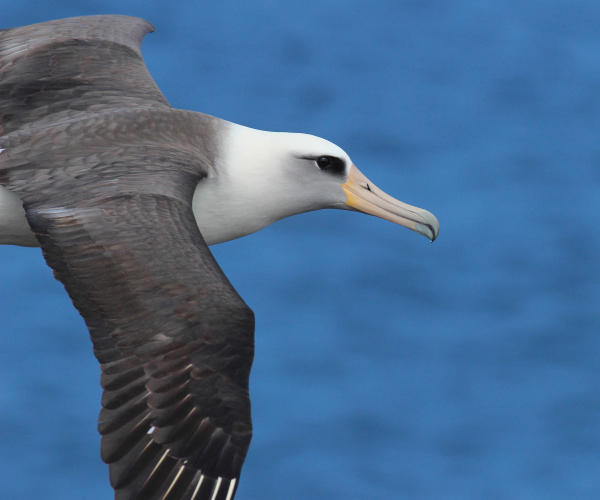
Among the mix of seabirds at Kilauea, one would occasionally make a close approach to yield impressive photos like this close portrait of an albatross as it glided by. The 1/800 shutter speed was adequately fast to stop the action and show details of the seabird few people get to view in the wild (photo info: 400mm telephoto lens, f-10 aperture, 1/800 shutter speed, ISO 400).
Hanalei NeNes
When I think of the Hanalei area, I immediately experience a low relaxed mode while shades of green permeate my psyche. Hanalei Refuge is a quiet valley filled with a stream, ponds, and lush vegetation with dramatic green mountain ridges in the background. My favorite evening of photographing there was preceded by a little rainstorm that broke to reveal beautiful evening sunlight. Because the sunlight was subdued, I dialed up my ISO level from the usual 400 setting to the 800 level, but it was not adequate under the pretty but low light level. So I dialed the ISO all the way to 1600 – an ISO level I almost never use. But it worked quite perfectly that evening, and my images showed no grain, which I’m always worried about with that high an ISO setting.
My primary interest there turned out to be the population of NeNes I encountered, a species I have long wished to get better of photos of since a brief photo op on the Big Island years before. At Hanalei I was able to photograph pairs, small flocks of nonbreeders, and some pairs with half-grown goslings. The NeNes provided a variety of photo ops, including feeding, resting, swimming geese, along with close portraits with the after-rain sunlight providing vibrant colors and sharp details.
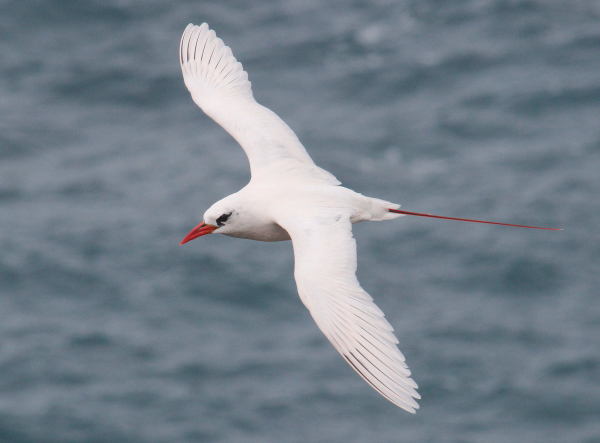
Kilauea provided a unique opportunity to photograph a variety of seabirds that are rarely seen elsewhere from shore, and the chance to photograph species like this gliding Red-tailed Tropicbird from a viewpoint slightly above the bird’s position created some unique perspectives within close quarters (350mm zoom lens, f-11 aperture, 1/800 shutter speed, ISO 800).
Between the 2 refuges, I sometimes encountered smaller songbirds, often in mixed flocks feeding on the ground. These were not native Hawaiian birds though, but a variety of the songbirds and doves that have been introduced to Hawaii in the past, creating a mix of species from Asia, Africa, and the Americas. I took advantage of the chance to photograph some of these birds, including Red-crested Cardinals, Java Sparrows, Common Mynas, and Zebra Doves.
In some of the same open grassy areas I tended to encounter the most common wintering species I found – Pacific Golden Plovers. The plovers provided interesting opportunities to photograph individuals in different stages of their molt from their basic plumage to their more colorful alternate plumage in advance of returning to their nesting range along the west coast of Alaska or northern Siberia.
Alakai Native Birds
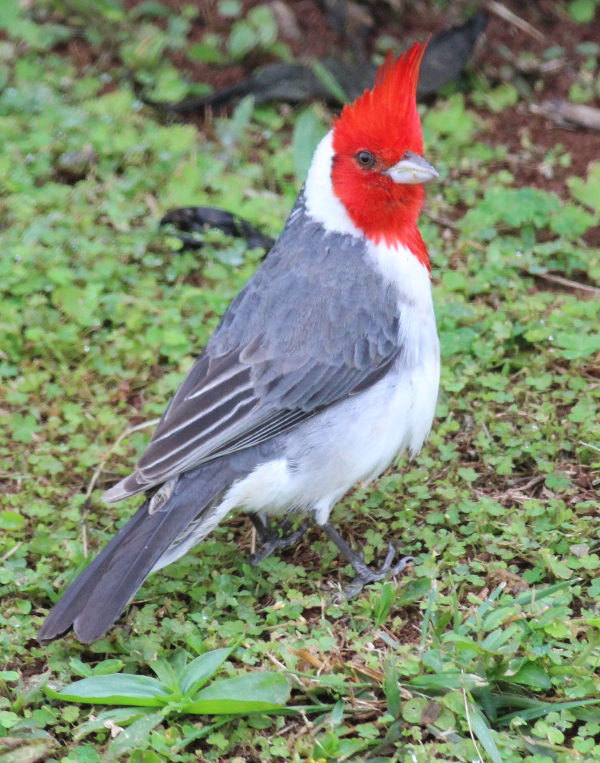
Many of the songbirds and doves we encounter in Hawaii have been introduced during previous decades, including the Red-crested Cardinal, which is native to southeast South America. A low light period required adjusting the ISO from 400 to 1600, but the resulting colors are warm and true (400mm telephoto lens, f-8 aperture, 1/400 shutter speed, ISO 1600).
|
One day I made a pilgrimage to the infamous Alakai Swamp, which was an all-day effort, circumnavigating the island to the end of the road on the northwest side. As the Hawaiian birds fly, Alakai is not that far from Hanalei, but if you are driving, it’s necessary to circle back around most of the island. So there is plenty to see along the way, especially as you pass picturesque Waimea Canyon and eventually arrive at Koke’e State Park, the gateway to Alakai.
I spent some hours getting to and walking along the upper reaches of the Alakai Swamp Trail in Koke’e State Park, but while I would have considered making a serious hike into the interior of the Alakai when I was in my 20s or 30s, it was a far steeper mountain trail than I could imagine that drizzly Sunday afternoon. I did enjoy seeing some native birds, and tried to photograph an Amakihi and I’iwi, but they were mostly active in the shadows in high tree branches, and the sunlight only rarely broke through the foggy clouds. Realistically, it takes a concerted effort and a lot more time than I could devote to the native songbirds, and it begs the need to return to Hawaii time and time again. Even so, within Koke’e I was able to get some nice images of a couple Erckel’s Spurfowl, interesting partridge-like birds introduced from northeast Africa.
Well, it was wonderful to revisit my bird photography trip to Kauai, where I enjoyed a variety of photo ops, some fruitful, some not; some exciting, some relaxed; all appreciated and all cherished. What fun I had during this island getaway, and the photos I took include some of my favorites – ever; anywhere. Back on the mainland, there will be a wealth of birds to photograph during the waves of migration that will pass through and deposit a host of local nesting birds during the next 10 weeks. Make the most of this rejuvenating season as you give your camera and lens a fitting workout as often as possible throughout the spring season – Good Luck!
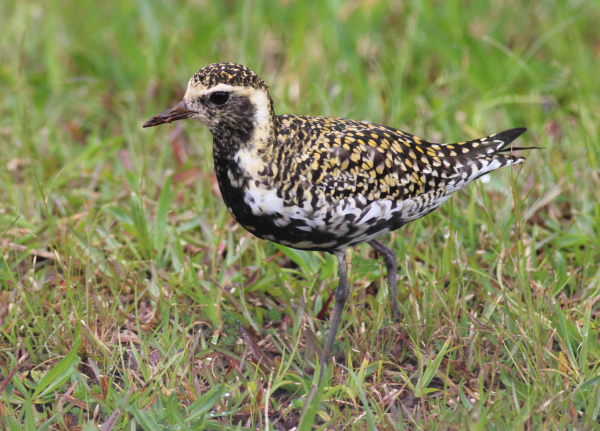
As remote as the Hawaiian Isles are in the middle of the broad Pacific Ocean, there were few migrants aside from Pacific Golden Plovers. These impressive shorebirds provided an opportunity to document a range of plumage changes as the plovers were molting from winter’s basic plumage to their alternate plumage before migrating north to the Arctic (photo info: 400mm telephoto, f-6 aperture, 1/800 shutter speed, ISO 800).
Article and photographs by Paul Konrad
Share your bird photos and birding experiences at editorstbw2@gmail.com